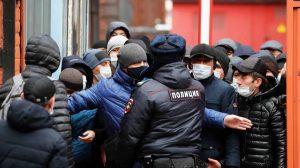The most popular strategy in the U.S. left at the moment has many names: “inside-outside,” “dirty break,” and “realignment.” These terms are all shorthand for the idea that socialists today should build a progressive wing inside the Democratic Party and prepare to break with the Democrats at some point in the distant future. This strategy is based on the premise that socialists can take a political apparatus of the imperialist bourgeoisie and turn it into an instrument for progressive change. This “democratic socialist” plan calls for taking over the Democratic Party and then gradually transforming the U.S. state apparatus—at each step, a tool of the capitalists is supposed to become a tool of the workers. “Democratic socialism” envisions a society much like the current one but with more security and control for working people.
Get your copy of Left Voice magazine, which includes this article.
The second-most popular strategy is called “base building.” This one term encompasses many different ideas. The idea that socialist organizations need to sink roots in the working class is of course important and correct—but hardly a strategy in itself. Socialists can organize community gardens, soup kitchens, or auto repair workshops in order to get to know their neighbors, and this kind of campaigning can win important gains, such as blocking an eviction. But there is no connection between these partial struggles and the goal of winning power. Organizations focused on base building generally lack any kind of common strategy. They think these “bases” will one day grow enough to confront and replace the capitalist state. But this is simply a different form of gradualism, and it ignores the inevitability of revolutionary situations and the need for decisive confrontations.
We present a third strategy, which we call the Soviet Strategy.1Large parts of this article are based on a talk given in Berlin on January 13, 2018. More information about how the Trotskyist Fraction tries to apply its strategy in the living class struggle can be found in the Spanish-language book Estrategia socialista y arte militar, which is currently being translated into English. This might sound like a reference to the old Soviet Union. But “soviet” is the Russian word for “council.” We are referring to a strategy based on workers’ councils, using the term made popular by the most successful socialist revolution in history, the October Revolution in Russia in 1917.
Socialist strategy must start from the premise that the working class is the central protagonist of social change. Workers have the social power to unite all other oppressed sectors in a struggle against capitalism. For the first time in history, the working class represents a majority of the global population, but it is also more fragmented than ever, in terms of both material conditions and political consciousness. The working class does not just include industrial workers: a worker is anyone who, not owning means of production, is forced to sell their labor power in order to survive.
It would be illusory to expect that the entire working class could develop socialist consciousness under capitalism. We should aim to convince as many workers as possible of Marxist ideas and use all means at our disposal to do so. But we should also understand that the bourgeoisie has infinitely greater means to impose its ideology than we do. Outside a revolutionary situation, only a minority of the working class can ever be truly revolutionary. Borrowing a term from military theory, this politically advanced minority can be called a “vanguard.”
The differentiation within our class is the basis for the tactic of the united front—an appeal that communist workers make to the entire working class, regardless of the organization to which they belong. The united front is based on a variety of simple demands, such as defending workers’ rights or fighting fascism. It includes calling on the leaders of all unions and other workers’ organizations—no matter how treacherous or bureaucratic they might be—to join the struggle. If they join, their members will be part of an action alongside communists. If they refuse, their members will see their leaders refusing to fight for very basic demands.
The united front usually begins as a defensive tactic: defense against assaults on our standard of living, defense of our democratic rights, defense against fascist violence, etc. Successful defensive actions increase the masses’ self-confidence and organization. They create the conditions for a transition to the offensive.
To cite a historical example, in Germany in the early 1930s, a workers’ united front against fascism would have integrated the workers’ parties and trade unions in direct actions against the Nazis. But to be effective, this united front would have required the formation of committees in factories and neighborhoods. Given the general context of economic catastrophe, these committees would also have needed to deal with questions of food, of rents, of wages—the defense committees would have transformed into general organs of struggle.
An organ that unites the entire working class for general struggle is, in a word, a soviet. The formation of a soviet marks the transition from the defensive to the offensive; soviets emerge when the working class, often unconsciously, begins to fight for political power. If they succeed and conquer, soviets become the organs that the working class uses to organize its political rule.
Soviets in History
Every revolutionary situation poses the question of power. The dilemma is how the organized socialist vanguard of the working class can unite the entire working class in a struggle for power. In this sense, soviets are simply the most complete form of the united front.
The workers of Petrograd solved this problem during the Revolution of 1905 when they formed the Council of Workers’ Deputies. This assembly was formed by delegates from all the workplaces, uniting representatives of all workers’ parties based on their support within the working class—similar to a workers’ parliament, but with representatives directly elected and subject to immediate recall. The name “soviets” continued to be used to describe this form of self-organization because the soviets played a central role in the Russian Revolution of 1917.
But Russia was not unique. During the German revolution of 1918-19, workers’ and soldiers’ councils were formed across the country. There were similar forms throughout the revolutions of the 20th century. For example, in the Bolivian Revolution of 1952, athe COB, the central trade union federation, became a kind of soviet and included delegates from all sectors of the working class. In Chile under the government of Salvador Allende (1970-73), workers’ delegates formed “cordones industriales” (industrial belts). In the Iranian Revolution of 1979-80, workers formed “shoras” (councils). When workers in the Stalinist states rose up against the bureaucracy, as in Hungary in 1956 and Czechoslovakia in 1968, they also formed council-like structures.
The names of such organs of self-organization vary depending on historical circumstances. The Parisian workers who rose up in 1871 called their government a “commune.” During the Spanish Revolution of 1930-39, Leon Trotsky suggested using the word “junta” for soviets, since that was more in line with the revolutionary tradition in the country.
This is not a question of fetishizing the term “soviet.” In fact, the Russian Bolsheviks did not fetishize the soviets themselves. In 1917, soviets were formed during the February Revolution, and during the initial months they remained firmly in the hands of “social patriots” who supported the imperialist war and the bourgeois provisional government. As the masses gained experience with this “democratic” government, which continued the imperialist war and delayed any serious reforms, they turned to the Bolsheviks. The Bolsheviks, in turn, began to win majorities in the soviets of large cities. It was the national congress of soviets—with a Bolshevik majority—that took power in October. This had been an earlier point of contention within the Bolshevik leadership. Lenin—then in exile in Finland—had been pushing for the Bolsheviks to carry out an insurrection under their own banner. It was Trotsky who instead proposed that the Petrograd soviet be used. The Bolsheviks may have represented a majority of the working class in Petrograd and Moscow, but the soviets had a far greater legitimacy to speak for the whole working class.
The question for modern revolutionaries is how to build organs that represent and unite the entire working class.
Soviets Without Bolsheviks?
Some leftists are in favor of workers’ councils. But do councils by themselves constitute a strategy? Can the working class beat capitalism simply by forming enough councils? The history of the German Revolution teaches us that it will not. In the days following the Kiel sailors’ mutiny on November 4, 1918, hundreds of workers’ and soldiers’ councils sprang up across Germany. After the insurrection reached Berlin five days later, the councils constituted a sort of provisional government. These councils, however, did not represent the will of millions of workers to end capitalism.2Nathaniel Flakin, “100 Years Ago in Berlin” (three–part article), Left Voice, November 9, 18 and 27, 2018.
Let us not forget that councils are formed in the heat of revolution. Perfect democratic norms are never fully implemented—certainly not at the beginning of a revolution, as millions of people swarm out onto the streets. In the beginning, reformist bureaucrats, adventurers, and swindlers often take the lead. In the early months of the German Revolution, for example, many soldiers elected their officers or apparatchiks from the Social Democratic Party (SPD) as their representatives. Before workers could elect new representatives, this alliance of the SPD and the military was already massacring communist leaders. And after the revolution suffered defeat, a number of communists wasted endless amounts of ink developing a “pure” council system. They constructed incredibly detailed blueprints for the perfect council. But councils emerge from real struggles, not from the plans of illustrious thinkers.
The lesson of the German Revolution is that workers’ councils without a revolutionary party do not lead anywhere. The workers’ and soldiers’ councils in Germany were dominated by the SPD—the party that was attempting to destroy the council system itself. The SPD had the majority of delegates at the national council congress, and they voted for a national assembly and a bourgeois republic. The centrist USPD, for its part, called for a model in which a bourgeois parliament and workers’ councils would complement each other—the utopia of permanent dual power. Only a very small minority within the councils, grouped in the Spartacus League and other groups, called for a socialist republic; the lack of a revolutionary party is why the councils were smashed by the counterrevolution.
Councils only represent a form. They can be filled with revolutionary content only if a revolutionary party—the common organization of the most conscious workers armed with a scientific program and a strategy—can win the leadership. In the hands of reformists, councils can just as easily be turned into tools of bourgeois rule. Only a revolutionary party can work out the program, strategy, and tactics necessary for the working class to conquer political power. This is a task that must be taken up before the revolution begins.
Soviets Don’t Fall From the Sky
We will seldom experience purely revolutionary or purely counterrevolutionary situations. In our era of capitalist decay, we will more often find ourselves in transitional situations that combine elements of both and can change suddenly. It is nonsensical to employ one strategy for a nonrevolutionary situation and a different strategy when it becomes a revolutionary one, as Karl Kautsky advocated. Strategy is the art of winning, and this includes using periods of capitalist stability to prepare for phases when that stability falls apart.
Councils do not arise automatically as soon as a revolution begins. What workers will do when a revolutionary crisis breaks out depends heavily on their prior experience. Trotsky noted that the workers in Petrograd founded their soviet spontaneously, without directives from the leaders of the workers’ parties. But this “spontaneity” was the result of years of political training by the Bolshevik party.
Some socialists show a tendency toward objectivism when considering the question of soviets. They look at a revolutionary situation and ask the yes-or-no question: “Did councils emerge there?” as if the conscious policies of revolutionaries had nothing to do with it.
An example of this came during the Spanish revolution. Andreu Nin was a leader of the Workers Party of Marxist Unification (POUM) and a former ally of Trotsky. He broke with Trotsky when the POUM came out in support of the popular front, an alliance between bourgeois and reformist parties committed to the defense of private property. When the revolution began, the POUM entered the Generalitat of Catalonia, a bourgeois government, and Nin became its minister of justice.
Trotsky said it was treason to join a bourgeois government; Nin answered that there was no alternative, since the Spanish Revolution had not produced anything like councils. There were, of course, manifold forms of self-organization by the workers and peasants of revolutionary Catalonia, but these did not become generalized, largely because the powerful anarchist current opposed any kind of centralization.
But the question is, what had Nin and the POUM done to unite all these bodies of self-organization via a congress of councils? Nothing—in fact, far worse than nothing. As minister of justice, Nin was responsible for dissolving revolutionary councils across Catalonia, in the name of standardizing the administration. Nin took on the task of personally dissolving revolutionary councils in POUM strongholds like Girona.
Revolutionaries do not just diagnose, as passive observers, whether the working class is creating organs of self-organization. Revolutionaries need to be the most determined force in establishing such bodies. This question played a major role when the Trotskyist Fraction emerged from the current of Nahuel Moreno, the International Workers League—Fourth International (LIT-CI by its name in Spanish). Moreno observed that soviets, which had been typical in revolutionary processes after World War I, had failed to reappear for the rest of the 20th century. But this claim is doubly wrong: First, it ignores the many examples mentioned above; second, it ignores how often councils were violently suppressed by social democracy and Stalinism.
In Moreno’s view, without councils, slogans like “all power to the soviets” made no sense. Instead, he proposed calling on workers’ and peasant’s organizations to take power. For example, when the revolutionary dictatorship in Argentina was toppled by mass mobilizations, Moreno correctly noted that there were no organs of worker self-organization. But he concluded from this that revolutionaries must call for bourgeois or petty-bourgeois parties to oppose imperialism and take power. Moreno’s organization had no program for developing such soviet-like bodies themselves. This objectivism regarding councils led Moreno to adapt to the forces of bourgeois democracy, even going so far as to consider “democratic revolution” a separate stage from “socialist revolution”—a central revision of Trotsky’s theory of the permanent revolution. The centrality of workers’ councils is an important part of the legacy of the Trotskyist Fraction and its break from Moreno.3This question is dealt with in a Spanish-language article: Emilio Albamonte and Fredy Lizarrague, “La estrategia soviética en lucha por la República obrera,” Estrategia Internacional, no. 4-5 (1993). Unfortunately it has never, to our knowledge, been translated into English.
What Does This Mean Today?
A revolutionary strategy does not begin with “storming the Winter Palace.” On the contrary, strategy means gathering forces to intervene decisively when a revolutionary situation arrives. If we believe that a socialist revolution requires workers’ councils and a proletarian party, this means doing everything we can to prepare the ground in the here and now. This has two implications:
- The working class must form organizations with an uncompromisingly revolutionary program. We should be dogged yet endlessly flexible when it comes to sinking roots in the working class. But we should also clearly oppose “democratic socialists” who operate in an imperialist party.
- We must develop forms of self-organization in every conflict. We want workers, youth, women, immigrants, Black people and LGBTQ+ people to hold assemblies wherever possible. As socialists, we should be the most dedicated partisans of assemblies as the ultimate decision-making body.
In fact, due to our preparation as organized socialists, we will find ourselves in a position to seize the leadership of a new movement even if we do not have a majority behind our program. But that would, at best, give us a tactical advantage. Conversely, as it is in our strategic interest for workers to develop experience with assemblies, it is better for an assembly to vote against our proposal than for us to impose our tactic via a maneuver.
The soviet strategy means that we push for self-organization in every conflict. Workers’ councils will not simply fall from the sky when a revolutionary situation emerges—they are a qualitative leap forward based on previous experiences with elected strike committees, assemblies, and other such forms.
In each conflict, we fight for the elements of a revolutionary program that are most relevant as part of a series of transitional demands. The communist program, for example, calls for the dissolution of the bourgeois military and repressive apparatus and for it to be replaced by workers’ militias. In a concrete struggle in 2019, this might mean calling for workers’ organized self-defense of picket lines, as a step toward more general forms of self-defense. Or in moments of heightened struggle, such as the yellow vest movement in France, it may be more systematic self-defense against state violence, coordinated by national assemblies.
The Yellow Vests in France, who have shaken the regime of one of the principal imperialist powers, have shown strong tendencies toward self-organization. The “assemblies of assemblies” in Commercy and Saint-Nazaire brought together delegates with mandates from assemblies across the country, and they used a majority vote to decide on their actions and demands. But the Yellow Vests, although mostly proletarian, lacked organic links to the large battalions of the working class. The bureaucratic leaderships of the trade unions were able to prevent workers from entering the struggle in an organized way. So while the Yellow Vests were able, again and again, to shut down the center of Paris, they could not shut down the French economy. This is precisely where a revolutionary party could have made a difference, fighting within the unions to mobilize workers while expanding the assemblies to include the entire working class.4See the article on the yellow vests in this issue. Or: “Inside the ‘Yellow Vest’ Rebellion—Interview with Daniela Cobet,” Left Voice, no. 4 (Spring 2019).
This soviet strategy is categorically opposed to that of “democratic socialists” (or in reality, social democrats) who want to manage the capitalist state in a different, better way. Our programmatic goal is completely opposed to this. We do not reject electoral work—we think socialists should use election campaigns (and wherever possible, parliamentary seats) to strengthen workers’ understanding of the need for an organization independent of the ruling class and its institutions. That is why we are completely opposed to “socialist” campaigns for Democratic Party candidates. Every initiative for independent socialist organizing across the United States will get our support; we want to combine them in a powerful revolutionary party.
The soviet strategy goes much further than that of base building, which attempts to build new working-class organizations under the leadership of socialists. We think revolutionaries need to work as fractions in broad organizations that encompass all tendencies within the working class. Such forms of self-organization are the framework in which socialists can win mass support for a revolutionary program with a clear strategy.
Notes
| ↑1 | Large parts of this article are based on a talk given in Berlin on January 13, 2018. More information about how the Trotskyist Fraction tries to apply its strategy in the living class struggle can be found in the Spanish-language book Estrategia socialista y arte militar, which is currently being translated into English. |
|---|---|
| ↑2 | Nathaniel Flakin, “100 Years Ago in Berlin” (three–part article), Left Voice, November 9, 18 and 27, 2018. |
| ↑3 | This question is dealt with in a Spanish-language article: Emilio Albamonte and Fredy Lizarrague, “La estrategia soviética en lucha por la República obrera,” Estrategia Internacional, no. 4-5 (1993). Unfortunately it has never, to our knowledge, been translated into English. |
| ↑4 | See the article on the yellow vests in this issue. Or: “Inside the ‘Yellow Vest’ Rebellion—Interview with Daniela Cobet,” Left Voice, no. 4 (Spring 2019). |











